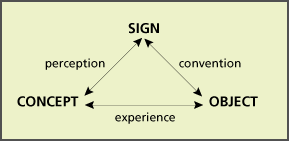HFCL GLOSSARY S
 . SELF . SELF-DISCLOSURE . SEMIOTICS
. SIGN . SOCIAL CONSTRUCTION OF
REALITY . SOCIETY . SPEECH
. SPEECH ACT THEORY . SYNTAGM
. SYSTEM .
. SELF . SELF-DISCLOSURE . SEMIOTICS
. SIGN . SOCIAL CONSTRUCTION OF
REALITY . SOCIETY . SPEECH
. SPEECH ACT THEORY . SYNTAGM
. SYSTEM .
SELF [HFCL TUTORIAL]
The individual human being. Human communication is said to originate within the minds of individual selves.

SELF-DISCLOSURE [HFCL TUTORIAL]
The act of providing others with information about oneself.

SEMIOTICS [HFCL TUTORIAL:]
Semiotic theory explains the process by which meaning arises during the perception and interpretation of sensory data. There are a number of variations of the model, however the semiotic triangle is probably the most common. The semiotic triangle model include three elements:
- a perception of something that exists in the physical world,
- an object or concept to which the perception is said to refer,
- a thought, image or concept that is formed in the mind as a result of the perception and which relates to the object.

It is this relationship, present among the elements of the many signs that human beings constantly encounter, that forms the basis for the patterns of meaning that develop in human communication. Models involving the use of signs have been developed by a number of semiotic theoreticians, most notably, Saussure and Pierce. See also Barthes, Eco.
Semiotic approaches to the analysis of communication texts often begin by
first identifying the paradigms involved.
The following is an example of a [paradigmatic
semiotic analysis]. More complex semiotic analysis focuses on the changes
that occur in the structure of the sygntagms
over time. The following is an example of a [syntagmatic
semiotic analysis].
OUTLINKS

SIGN
Loosely defined as "a pattern of data which, when perceived, brings to mind
something other than itself," the notion of the sign is central to the semiotic
approach to the study of communication. The term can refer to the relationship
among the elements of the semiotic model, or it can be used to indicate
the first of the three elements, i.e., the physical thing perceived.

SOCIAL CONSTRUCTION OF
REALITY [HFCL
TUTORIAL: THE COMMUNICATION ENVIRONMENT]
The theory, as expounded by Berger
and Luckmann, that the actions of human beings as they live their everyday
lives create a social reality that is as unavoidable as the non-social reality
that is usually termed "nature."
[Summary of the Model]

SOCIETY
Although any group of humans connected by means of communications may be termed a "society," the term usually refers to a very large group that has developed a wide variety of shared languages, institutions and behaviors.
OUTLINKS

SPEECH [HFCL
TUTORIAL: SIGNS AND LANGUAGE]
A form of communication that propagates messages using language via the
medium of sound.
Speech is generally acscribed only to humans, although arguments are made
in support of beings such as dolphins, whales and various primates.
TO GIVE A SPEECH: to speek formally to an audience.
Speeches of this type may be categorized as informative, persuasive, and
so on as described in the study of Rhetoric.
SPEECH COMMUNICATION: the study of speaking and speech. This may involve
the biology, physiology, physics, psychology and sociology of the speech
act. It may involve the study of the art of public speaking. It may involve
the analysis of the nature of speech in social discourse.
OUTLINKS

SPEECH ACT THEORY [HFCL TUTORIAL: RELATIONSHIPS]
The study of human speech as action.
See also: Searle.

SYNTAGM [HFCL TUTORIAL: SEMIOTICS]
In semiotics a sign constructed from other, more fundamental signs. The set of available fundamental signs is called the paradigm of the syntagm.

SYSTEM [HFCL TUTORIAL: THE COMMUNICATION PROCESS]
A collection of interrelated parts. The parts and relationships that comprise the system are distinguished from the rest of the world (or the environment) by a boundary.
Systems theory is the study of the nature of systems. Systems analysis is the engineering discipline that uses systems theory as a framework for studying and modifying the world.
See also: Weinberg, Wilden, Boulding
OUTLINKS:

TOP OF THIS PAGE


![]()